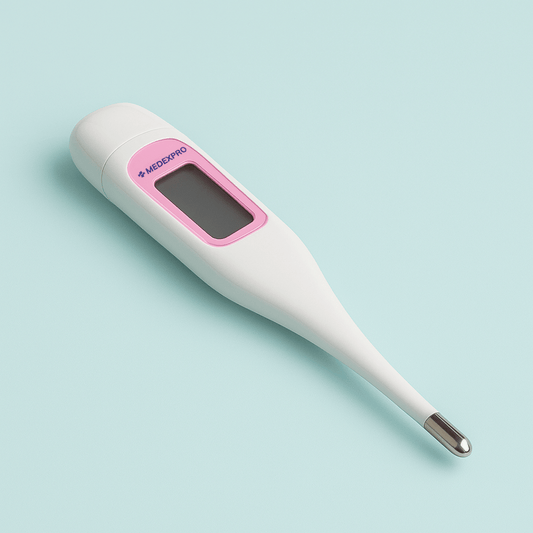BBT Tracking: Does It Really Work for Predicting Ovulation?

What Is BBT Tracking?
Basal Body Temperature (BBT) tracking is one of the oldest and most widely used methods for understanding fertility. Your BBT is your body’s lowest resting temperature, taken right after you wake up in the morning and before you move around, eat, or even sit up. The idea is simple: by charting small changes in this temperature over time, you can learn more about when ovulation has occurred.
When ovulation happens, the hormone progesterone rises. Progesterone warms the body slightly — usually by about 0.2–0.5°C. This subtle shift is what BBT tracking looks for. Over the course of a few cycles, a pattern begins to emerge, and you can start to see the phases of your cycle reflected in your chart.
How BBT Changes Across Your Cycle
During the first half of your cycle (the follicular phase), temperatures are generally lower and stable. Around ovulation, some people notice a tiny dip in temperature right before the egg is released. After ovulation, progesterone kicks in, and your chart will usually show a noticeable rise — not dramatic, but enough to spot if you’re taking your readings daily.
This rise continues through the luteal phase (the second half of your cycle). If pregnancy occurs, progesterone levels stay high and temperatures remain elevated. If not, progesterone drops just before your period, and so does your temperature.
Can BBT Predict Ovulation?
Here’s where it gets a little tricky. BBT tracking confirms that ovulation has already happened, but it doesn’t reliably predict it ahead of time. The temperature rise only occurs after the egg has been released, so you can’t use BBT alone to know when to time insemination or intercourse that same cycle.
However, the value of BBT lies in the bigger picture. By charting consistently, you can start to recognise your personal patterns: how long your follicular phase usually lasts, when your temperature tends to shift, and how steady your luteal phase is. Over a few months, this information can help you estimate when ovulation is likely to happen in the future.
The Role of Consistency (and the Challenges)
BBT tracking only works if it’s done with accuracy and consistency. You need to take your temperature at the same time every morning, ideally after at least three hours of sleep, and before getting out of bed. Even small disruptions, like waking up earlier than usual, drinking alcohol the night before, being sick, or sleeping in a cold room — can affect your readings.
This can make the method frustrating for people with irregular schedules or cycles. For example, if you do shift work, have a baby who wakes you at night, or travel often, your temperatures may be harder to interpret.
Benefits and Limitations of BBT Tracking
The biggest benefit of BBT tracking is awareness. It helps you confirm that ovulation is happening and gives insight into the length of your luteal phase — which can be important if you’re trying to identify issues with progesterone or cycle length. It’s also completely free once you have a thermometer, making it accessible to anyone.
The limitation is timing. Because the temperature rise happens after ovulation, BBT alone won’t tell you the exact fertile window in real time. That’s why many people combine it with other methods, such as monitoring cervical mucus or using ovulation kits like OvaDetect, which measure the LH surge before the egg is released. Together, these methods give both prediction and confirmation.
Does It Really Work?
The answer depends on what you’re using it for. If you want to predict ovulation in the moment, BBT by itself isn’t the most reliable tool. If you want to confirm ovulation and understand your cycle patterns over time, then yes — BBT tracking can be incredibly effective. It works best as part of a holistic fertility awareness approach rather than a stand-alone method.
BBT tracking is more than just numbers on a chart — it’s a way of tuning into your body’s natural rhythms. While it can’t predict ovulation with the precision of an ovulation test, it offers valuable confirmation and deeper understanding of your cycle. For many, it’s also emotionally grounding: a daily ritual that brings a sense of connection and control during the sometimes overwhelming TTC journey.
If you’re curious to try it, start with a reliable digital thermometer like OvaTrack and commit to a few cycles of daily tracking. Be patient with yourself as you learn — your chart will become clearer with time. And remember, the goal isn’t perfection; it’s connection, awareness, and support on your path to conception.

If you need help going through any block, talking with a TTC consultant can help! Book a FREE 15-minute virtual consult today!
Book a TTC consultation











